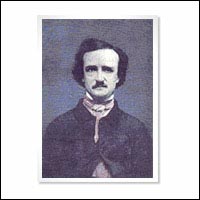 Physician Lombrosos wrote about the links between “genius and madness” in 1889. His ideas continued until Lewis Terman’s data in 1925 suggested that individuals of high ability demonstrated fewer incidences of mental illness than average.
Physician Lombrosos wrote about the links between “genius and madness” in 1889. His ideas continued until Lewis Terman’s data in 1925 suggested that individuals of high ability demonstrated fewer incidences of mental illness than average. While Terman was publishing his findings, Sigmund Freud analyzed creative people, because he believed that “the study of artists’ and writers’ lives would reveal basic psychological truths in persons of heightened sensibility and talent” (Neihart 47-50).
Since Freud, more diagnostic studies support the cognitive links between creativity and madness. One ambitious study was The Life and Works of Edgar Allan Poe. A Psycho-Analytic Interpretation by Marie Bonaparte in 1933. It was translated from French into English by John Rodker in 1949. Bonaparte contends that much of Poe’s writing reflects his psychological temperament.
Dr. Kay Redfield Jamison, co-author of the standard medical text, Manic-Depressive Illness, published her landmark study of manic-depressive illness and “its relationship to the artistic temperament and imagination” in her book, Touched With Fire: Manic-Depressive Illness and the Artistic Temperament in 1993. Jamison discusses Poe and more than 175 writers, composers, musicians, and artists and argues that “the most creative” suffer “disproportionately from depression and manic depression.”
Jamison supports her arguments by analyzing primary sources of creative artists, allowing them to speak for themselves and by citing the “extraordinary advances in genetics, neuroscience, and psychopharmacology” (Jamison PBS).
If scientific data supports the analysis that Poe suffered from a mood disorder, what new insights can be revealed in Poe’s literature? In addition to the intensity of emotional expressiveness that writers experience, who suffer manic-depression, Max Byrd in his 1974 book, Visits to Bedlam, Madness and Literature in the Eighteenth Century,” suggests, “…This modern melancholy is essentially an enhanced self-awareness, since the ego is the pivot round which the sphere of joy and grief revolves.”
This quote is from Raymond Klibansky and colleagues' book, Saturn and Melancholy. By interpreting some of Poe’s works that reflect an “enhanced self-awareness” about the universal “sphere of…grief”, my research attempts to emphasize the unique ways that Poe’s rhetoric engages the reader through passages of loss, such as abandonment, alienation, and grief.
Moreover, when analyzed through the lens of Freud’s observation that “melancholia sharpens the ambivalence of the love relationship as it disposes the mourner to self-punishment,” George Kennedy believes that Poe’s rhetoric has not been examined significantly for its psychoanalytic, literary interpretations and its benefits for human understanding. In his essay, “The Violence of Melancholy: Poe against Himself,” Kennedy contends that Poe’s fiction can be understood within the mind’s “twisted relations.”
Additional literature support Kennedy’s views: Edgar A. Poe: Mournful and Never-Ending Remembrance by Kenneth Silverman; “Paul Bowles and Edgar Allan Poe: The Disintegration of the Personality” by Wayne Pounds; Midnight Dreary: the Mysterious Death of Edgar Allan Poe by John Evangelist Walsh; and “Poe and the Powers of the Mind” by Robert Schulman.
On counterpoint, Poe is trivialized by some experts. In F. O. Matthiessen’s famous classic, American Renaissance: Art and Expression in the Age of Emerson and Whitman, Poe is barely mentioned. Moreover, Wilt Napier argues in his essay, “Poe’s Attitude toward His Tales,” that Poe’s desperate financial straits stimulated him to “reduce to a formula” writing that would sell in popular magazines. Napier also criticizes those that “lean too heavily on the now fashionable ‘psychological’ method of biography” to analyze Poe’s literary work.
Poe writes about his struggle with manic-depression in his book Marginalia and in letters and notes that are included in Jamison’s book. She explains, “writers and artists themselves have been particularly forceful about the relief that their work can bring.” Her example is Anne Sexton, who said, "Poetry led me by the hand out of madness" (Jamison 122). By studying Poe’s writing through a multidisciplinary, theoretical approach, his rhetoric has the potential to lead people “by the hand out of madness” to process the pangs of unbearable suffering.







2 comments:
was writing in a dark mysterious tone the norm for 19th century authors?
Fine springboard for discussion.
Readers all too often have axes to grind (who doesn't) when they give Poe a psychiatric label (Marie Bonaparte's is perhaps the most widely circulated).
In the absence of great detail on Poe's personal life outside his family homes, there is seemingly endless speculation on his vices and the extent to which they might have overlapped with that of the monomaniacal narrators of his most popular fiction.
PS--yes, the dark mysterious tone was a favorite--Check Charles Brockden Brown and sensation fiction from Blackwood's Edinburgh Magazine, 1817ff, accessible via the Hathitrust Digital Library:
http://babel.hathitrust.org/cgi/pt?id=mdp.39015030603990
Post a Comment